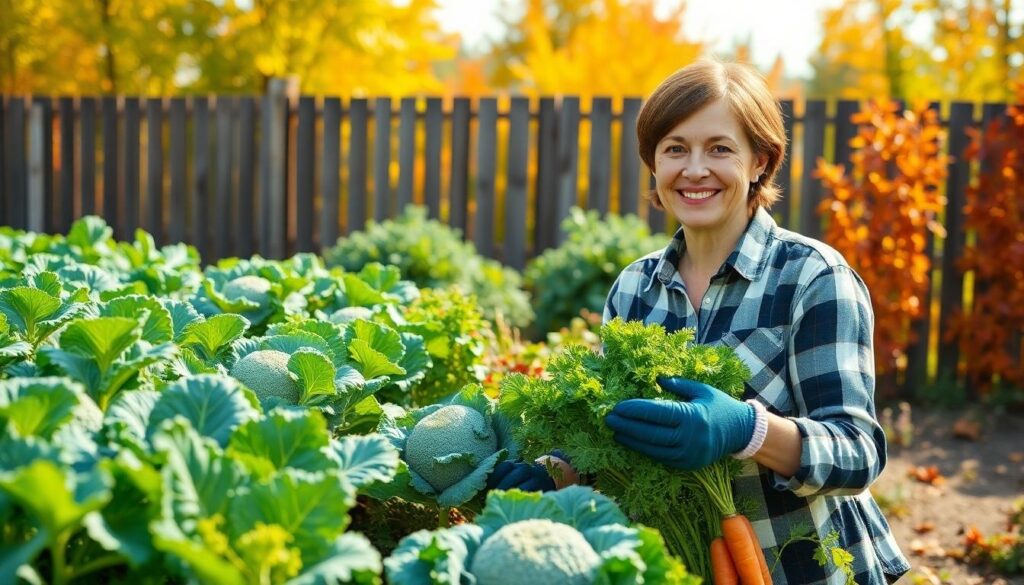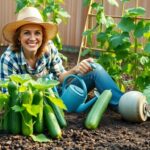As the summer heat gives way to crisp autumn air, we’re excited to share our favorite fall vegetable gardening ideas that’ll transform your backyard into a bountiful harvest. Fall offers the perfect conditions for many vegetables to thrive—cooler temperatures, fewer pests, and gentler sunlight create an ideal environment for growing delicious, nutritious produce.
We’ve spent years perfecting our fall garden strategies, and now we’re bringing those techniques to you. From selecting frost-tolerant varieties to maximizing limited space, our proven approaches will help extend your growing season well into the cooler months. Whether you’re a seasoned gardener or just starting out, these fall vegetable garden ideas will inspire you to grab your gardening gloves and make the most of this productive season.
10 Essential Fall Vegetable Garden Ideas for a Bountiful Harvest
1. Choose Cold-Hardy Vegetables
Cold-hardy vegetables thrive in fall’s cooler temperatures and often taste better after light frosts. We recommend focusing on crops like kale, Brussels sprouts, cabbage, and spinach that can withstand temperatures down to 28°F. Leafy greens such as arugula, mustard greens, and Swiss chard also perform exceptionally well in autumn conditions. Plant these varieties at least 6-8 weeks before your first expected frost date to ensure they reach maturity before severe cold arrives.
2. Extend Your Growing Season with Protection
Season extension techniques allow you to garden weeks or even months longer than your climate typically permits. Cold frames, which are essentially mini greenhouses, can increase soil temperatures by 5-10 degrees and protect plants from frost. Row covers made of lightweight fabric provide 2-8°F of protection while allowing light, water, and air to reach your plants. Cloches (individual plant covers) work perfectly for protecting single plants like tomatoes or peppers from early fall frosts.
3. Prepare Your Soil Properly
Fall soil preparation sets the foundation for successful autumn crops. We suggest adding 2-3 inches of compost to replenish nutrients depleted by summer crops. Testing your soil pH (ideally between 6.0-7.0 for most vegetables) helps identify any amendments needed before planting. Incorporating aged manure or organic fertilizers with higher phosphorus and potassium ratios supports root development and cold hardiness in fall vegetables.
4. Practice Succession Planting
Succession planting maximizes your garden’s productivity by staggering crop plantings every 1-2 weeks. Quick-growing vegetables like radishes, lettuce, and spinach can be planted multiple times throughout fall. This method ensures continuous harvests rather than experiencing feast-or-famine cycles. Creating a planting calendar based on your first frost date helps organize when each succession should begin.
5. Use Mulch for Temperature Regulation
Mulching provides crucial temperature regulation as days grow shorter and nights cooler. Organic mulches such as straw, shredded leaves, or pine needles applied 2-4 inches thick insulate soil against temperature fluctuations. This layer preserves warmth during cold nights while preventing overheating on sunny fall days. Mulch also suppresses weeds that compete with your vegetables for nutrients and retains moisture in the soil.
6. Plant Garlic and Overwintering Crops
Fall marks the perfect time to plant garlic and other overwintering crops that will produce early harvests next spring. Garlic cloves planted 2 inches deep and 6 inches apart in mid-fall will develop roots before winter dormancy. Varieties like hardneck garlic typically produce larger bulbs in northern regions. Other excellent overwintering options include certain onion varieties, spinach, and fava beans that can survive under snow cover and resume growth at the first signs of spring.
7. Convert Vertical Spaces for More Growing Area
Vertical gardening techniques become particularly valuable in fall when garden space may be limited. Trellises, cages, and fences can support climbing peas, beans, and cucumbers while keeping them off cold ground. Wall-mounted planters or hanging baskets positioned in sunny locations provide additional growing space for compact greens like lettuce and herbs. This approach increases your growing area by 30-40% without expanding your garden’s footprint.
8. Carry out Strategic Crop Rotation
Crop rotation prevents soil-borne diseases and pests from building up in your garden beds. We recommend avoiding planting vegetables from the same family in the same location for at least 3-4 years. Fall provides an excellent opportunity to break cycles by planting different family crops than what grew during summer. For example, follow tomatoes (nightshade family) with brassicas like broccoli or cauliflower for optimal soil health and disease prevention.
9. Harvest at the Right Time
Optimal harvesting techniques preserve both flavor and storage quality of fall vegetables. Root vegetables like carrots, beets, and turnips actually become sweeter after light frosts trigger them to convert starches to sugars. Leafy greens should be harvested in the morning when they’re most crisp and hydrated. Many fall vegetables can remain in the ground and be harvested as needed, creating a living refrigerator that keeps produce fresh longer than conventional storage methods.
10. Prepare for Winter While You Harvest
Simultaneous harvesting and winter preparation streamlines your fall garden maintenance. Removing spent plants immediately prevents potential disease carryover to next season. Covering empty beds with 3-4 inches of shredded leaves or straw protects soil structure and feeds beneficial microorganisms through winter. Planting cover crops like winter rye or crimson clover in harvested areas prevents erosion while adding organic matter and capturing nutrients that might otherwise leach away during winter precipitation.
Choosing the Right Cool-Season Vegetables for Your Fall Garden
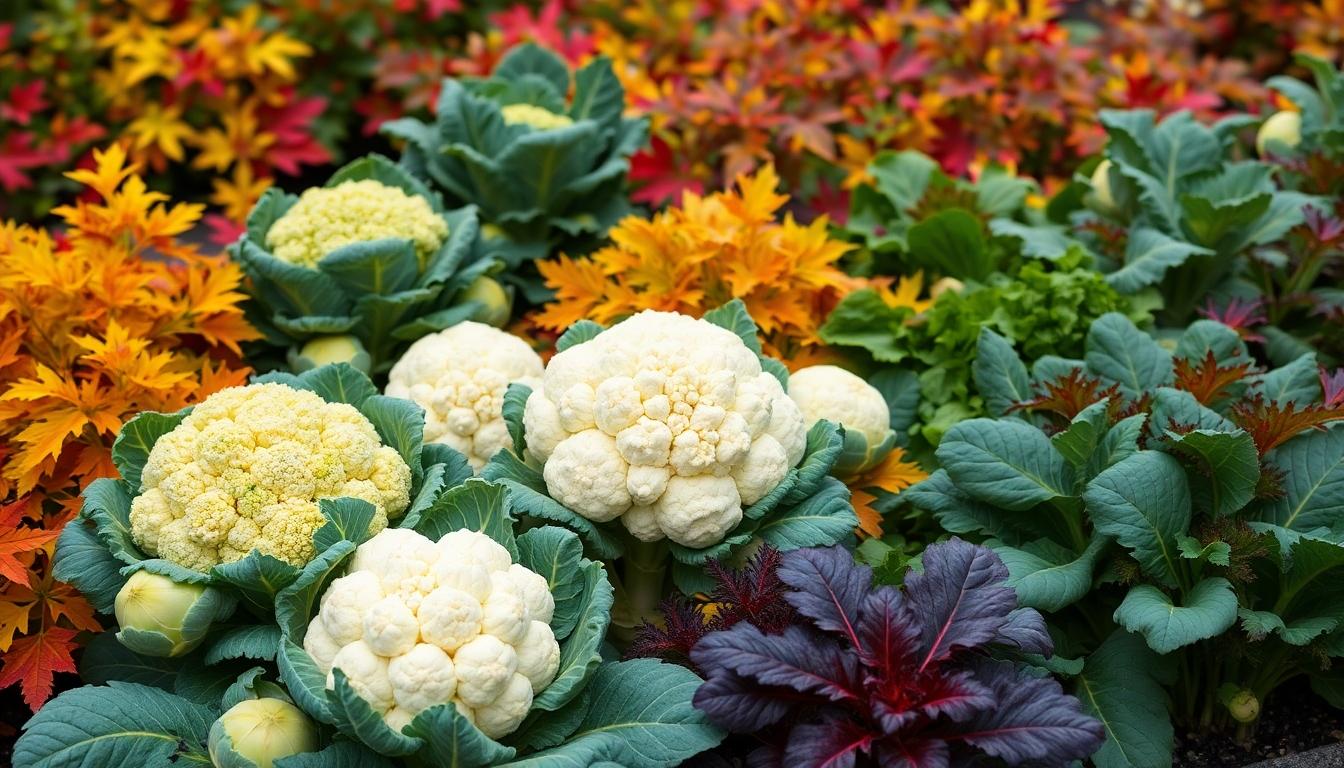
Fall gardening allows you to extend your growing season with vegetables that actually prefer cooler temperatures. We’ve selected the best cool-season crops that will thrive as summer heat fades and autumn arrives.
- Broccoli – This nutritious vegetable matures quickly in fall’s milder conditions, ready for harvest in just 55 days. Broccoli develops sweeter flavors when grown during cooler weather, making it an excellent choice for autumn gardens.
- Cauliflower – Similar to its cruciferous cousin, cauliflower thrives in fall’s climate and reaches maturity in approximately 60 days. The cooler temperatures help cauliflower develop tight, white heads without the bitterness that can occur in summer heat.
- Brussels Sprouts – These miniature cabbage-like vegetables require patience with their 90-day maturation period, but fall’s cooler temperatures create the perfect conditions for developing their characteristic nutty flavor. Brussels sprouts actually improve in taste after light frost exposure.
Fast-Growing Leafy Greens for Quick Returns
- Lettuce – Ready in as little as 20 days, lettuce varieties provide fast returns in your fall garden. Many types can be harvested using the cut-and-come-again method, allowing multiple harvests from a single planting.
- Spinach – This nutrient-dense leafy green reaches maturity in approximately 20 days and performs exceptionally well in autumn’s shorter daylight hours. Spinach actually becomes sweeter and more tender when grown in cooler weather.
- Arugula – Known for its distinctive peppery flavor, arugula can be harvested just 20 days after planting. Fall’s milder temperatures help temper arugula’s spiciness while maintaining its robust flavor profile.
Root Vegetables That Thrive in Cooler Weather
- Beets – Ready to harvest in about 50 days, beets develop their sweet, earthy flavor best in fall’s cooler soil temperatures. Both the roots and greens can be harvested, providing two vegetables from a single plant.
- Radishes – These crisp root vegetables mature incredibly quickly, often ready in just 20 days. Radishes grown in fall tend to be less spicy and more tender than their summer counterparts.
- Carrots – Taking 60-70 days to mature, carrots benefit from fall’s cooling soil temperatures that trigger the conversion of starches to sugars. Fall-grown carrots typically develop sweeter flavors and can often be left in the ground and harvested as needed.
Extending Your Growing Season with Protective Structures
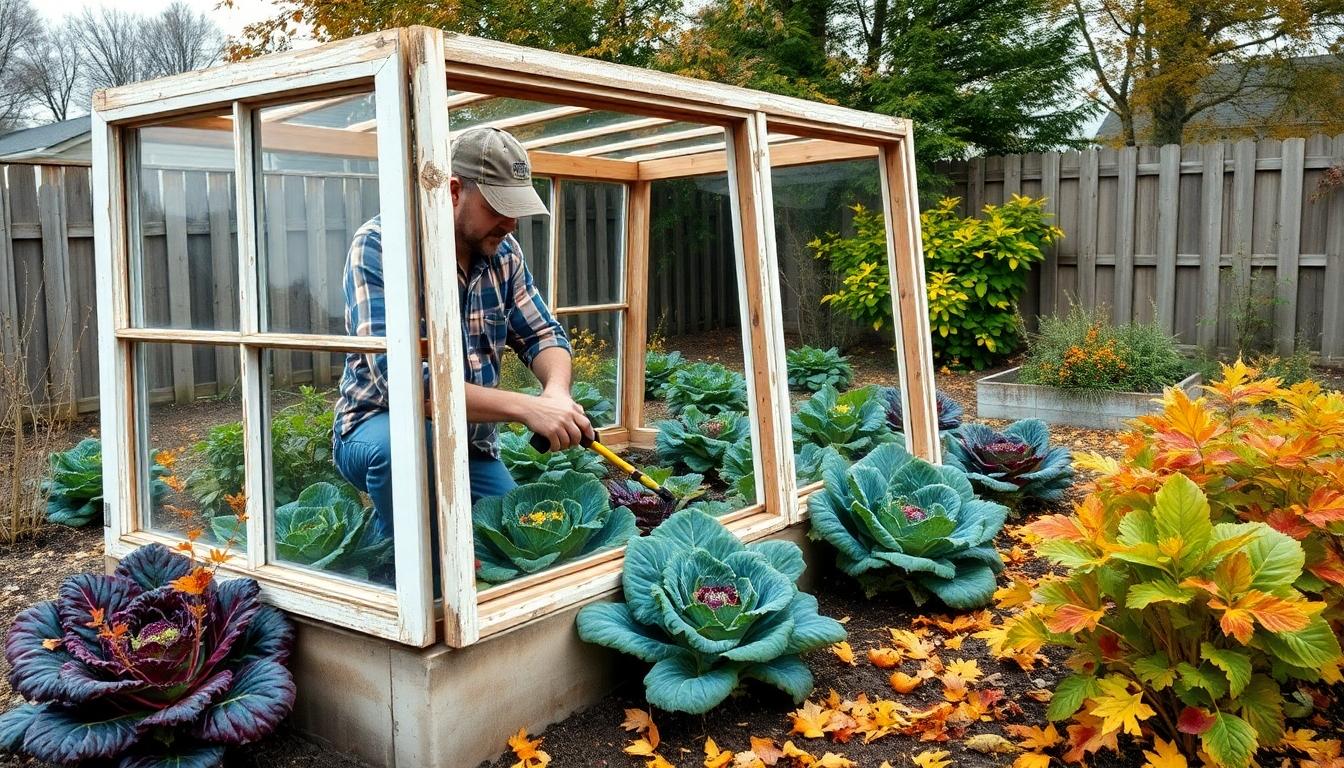
Don’t let early frosts cut your fall harvest short! With the right protective structures, you can extend your growing season by weeks or even months, enjoying fresh vegetables well into winter.
Building Simple Cold Frames and Row Covers
Cold frames offer exceptional protection for fall crops by creating miniature greenhouse environments that trap heat and shield plants from frost. You can easily construct DIY cold frames using old windows or polycarbonate sheets mounted on wooden frames, positioning them in sunny, wind-protected areas of your garden. These transparent-roofed enclosures are perfect for protecting frost-tolerant crops like kale, cabbage, and lettuce as temperatures begin to drop.
Row covers provide another simple solution for extending your harvest season. These lightweight fabric or plastic covers float directly over your plants, creating a protective barrier against early frosts while still allowing light, water, and air to reach your crops. For optimal results, choose heavier fabric weights for colder weather protection or vented plastic options that promote proper airflow. Many gardeners use row covers to safeguard spinach, lettuce, and other leafy greens, enabling continuous harvests even as temperatures fluctuate in late fall.
Setting Up Mini Hoop Houses for Weather Protection
Mini hoop houses combine the benefits of cold frames and row covers, offering versatile protection for larger planting areas. You can construct these structures using PVC pipes or metal hoops inserted directly into the soil about 2-3 feet apart, then covering them with clear plastic or frost cloth secured with clips or weights. The resulting tunnel creates a microclimate that protects frost-sensitive crops like late-season squash, bush beans, and cucumbers from temperature drops.
Ventilation becomes crucial when using mini hoop houses, especially on sunny fall days when temperatures inside can rise dramatically. Open the ends or sides during peak daylight hours to regulate humidity and prevent overheating, then close them before evening to retain warmth overnight. These protective tunnels maintain soil temperatures several degrees higher than exposed ground, extending your growing window significantly. For best results, place mini hoop houses in locations that receive maximum sunlight exposure during shortened fall days, ensuring your plants receive adequate light for continued growth and development.
Preparing Your Soil for Fall Planting Success
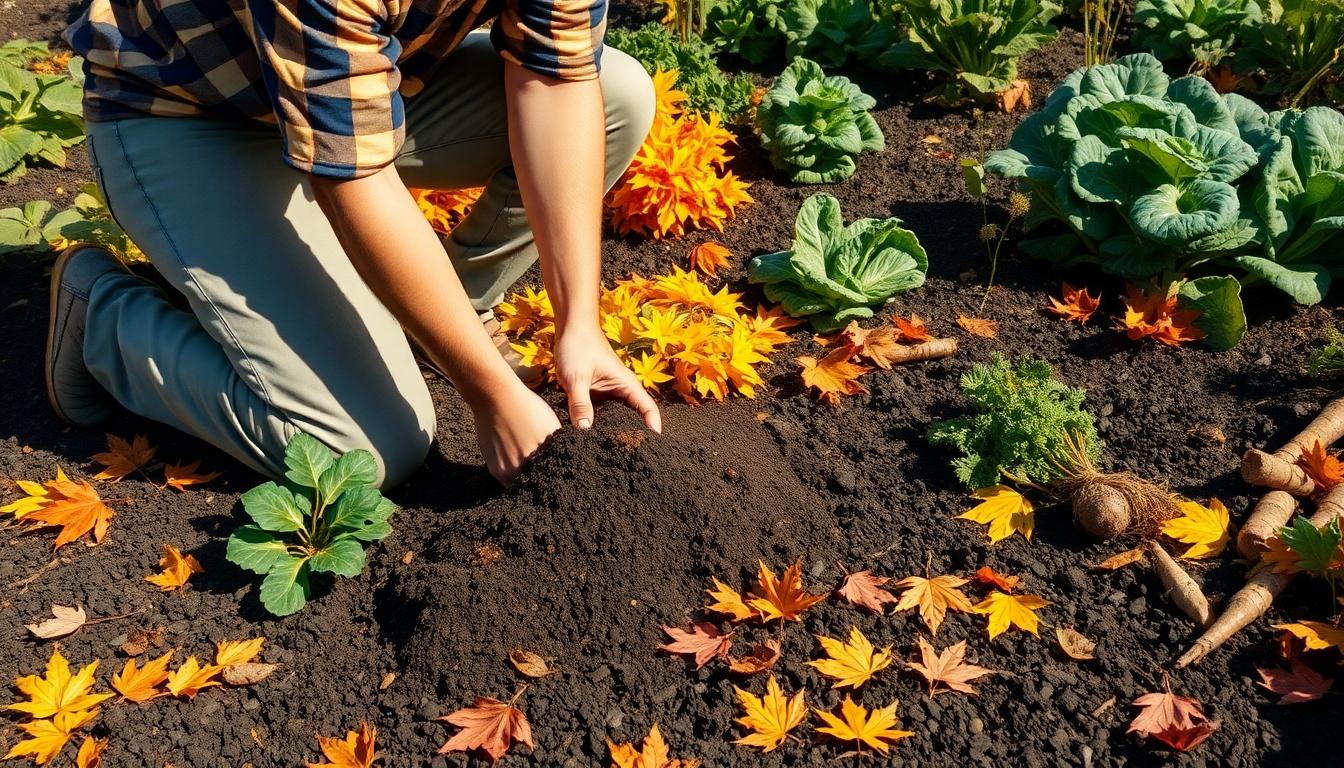
Proper soil preparation is the foundation of any successful fall vegetable garden. Taking time to optimize your soil conditions now will reward you with healthier plants and more abundant harvests as temperatures drop.
Incorporating Compost and Amendments
Soil testing is essential before adding any amendments to your fall garden beds. We recommend conducting a comprehensive soil test to determine the pH and exact nutrient levels, as most fall vegetables thrive in a slightly acidic to neutral pH range of 6.2 to 6.8. Adding high-quality compost to your garden beds significantly enhances soil structure, improves fertility, and promotes overall soil health. Compost works wonders by simultaneously improving drainage in heavy soils and increasing moisture retention in sandy soils. Based on your soil test results, you’ll need to incorporate exact amendments to adjust pH levels or address nutrient deficiencies that might limit your fall crops’ productivity. Organic matter breaks down more slowly in cooler fall temperatures, making this season ideal for building long-term soil health that benefits both current plantings and next year’s garden.
Mulching Techniques for Temperature Regulation
Temperature control becomes crucial during the transition from summer to fall, and proper mulching helps maintain ideal soil conditions for your vegetables. Mulch acts as an insulating layer that moderates soil temperature—keeping it cooler during late summer heat and warmer as fall progresses and temperatures drop. Moisture retention is another important benefit of mulching, as it reduces evaporation and minimizes the need for frequent watering during unpredictable fall weather patterns. Organic mulches such as straw, shredded leaves, or wood chips effectively suppress weeds that would otherwise compete with your vegetables for valuable water and nutrients. Apply a 2-3 inch layer of mulch around your plants, being careful to keep it from directly touching the stems to prevent rot issues. Darker mulches can help absorb more heat during the day and release it slowly at night, providing additional frost protection for your fall vegetables.
Strategic Planting Schedules for Fall Harvests
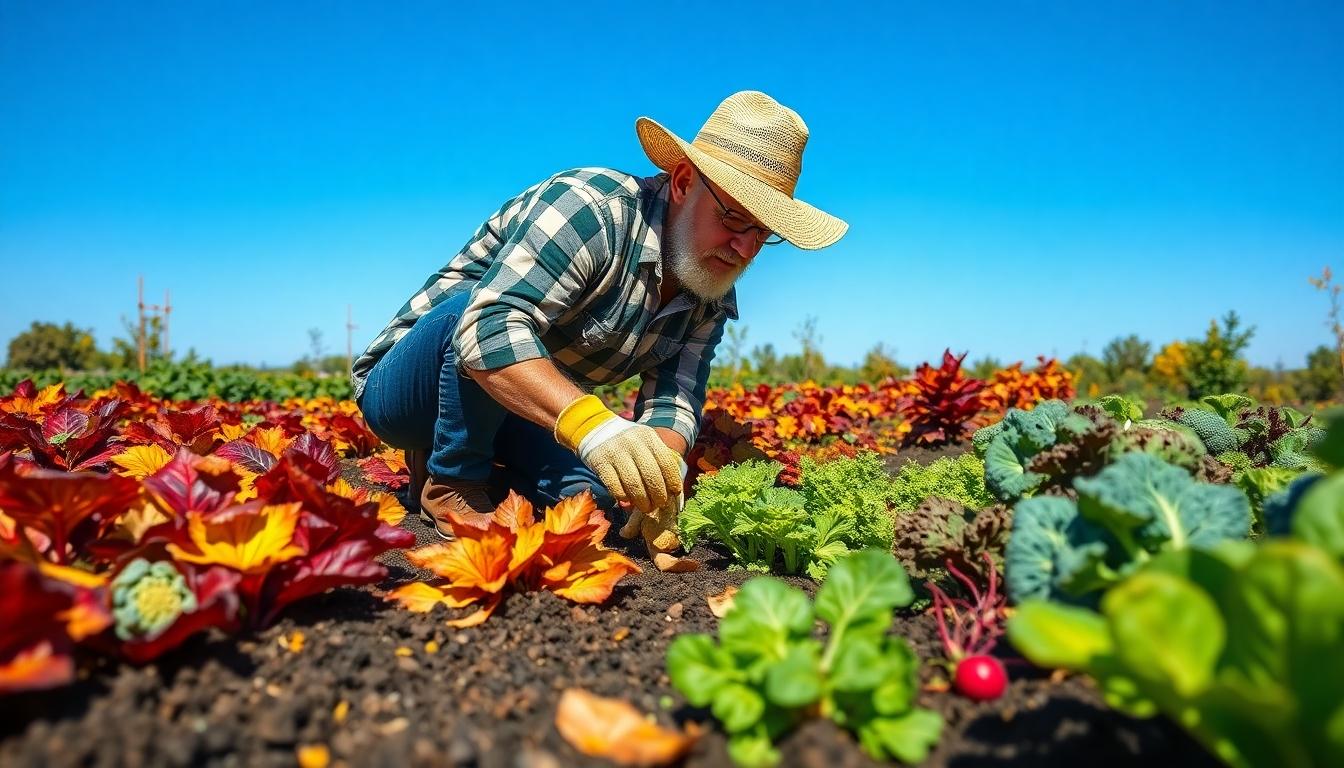
Timing is everything when planning a productive fall vegetable garden. Knowing exactly when to plant each crop ensures you’ll enjoy a bountiful harvest before winter arrives.
Calculating First Frost Dates and Planting Windows
The first frost date serves as the crucial deadline for your fall garden planning. Start by researching your area’s average first frost date through local weather services or historical climate data. Once you’ve determined this date, work backward based on each vegetable’s maturation period. Broccoli and cauliflower, for instance, require approximately 55-65 days to reach maturity, so you’ll need to plant them at least two months before your expected frost. Cool-season crops like lettuce, spinach, and radishes mature more quickly and can be planted closer to the frost date. Before sowing seeds directly in the garden, prepare your soil by cooling it down—simply shade the planting area for several days and ensure it remains consistently moist. This creates ideal germination conditions for fall vegetables that prefer cooler temperatures to thrive.
Succession Planting for Continuous Yields
Succession planting maximizes your garden’s productivity throughout the entire fall season. Plant seeds in strategic intervals—typically every two weeks—to ensure continuous harvests rather than a single large yield. Implementing crop rotation principles maintains soil health and prevents disease buildup. For example, after harvesting beans or peas, leave their nitrogen-fixing roots in the soil, then plant nutrient-hungry crops like broccoli or carrots in that same spot. Cold frames and DIY coverings offer excellent protection for extending your growing season when temperatures begin to drop. These simple structures shield tender plants from early frosts, potentially adding weeks or even months to your harvesting window. By utilizing these succession techniques, your fall garden can provide fresh vegetables well into the cooler months when most gardens have already stopped producing.
Fall Container Gardening for Limited Spaces
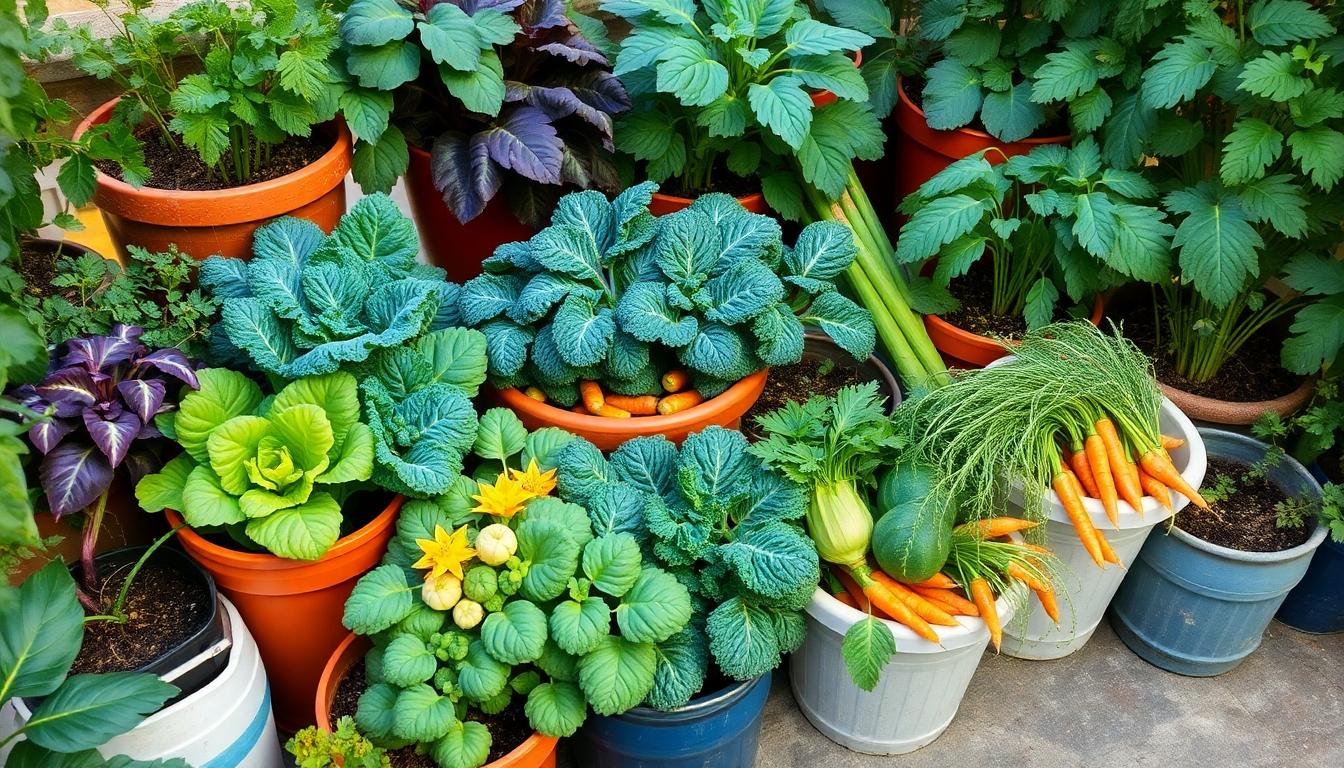
Container gardening offers an excellent solution for those with limited outdoor space like balconies, patios, or small yards. We can maximize these compact areas using pots, grow bags, and vertical growing systems while maintaining an attractive garden aesthetic.
Best Vegetables for Fall Container Growth
Kale thrives exceptionally well in fall containers, developing sweeter flavors after light frosts. Collard greens offer another excellent option, providing nutritious harvests throughout the cooler months. Lettuce and arugula grow quickly in containers, allowing for multiple harvests before winter sets in. Carrots can be grown successfully in deeper pots, with their flavor improving significantly in cooler temperatures. Root vegetables like beets adapt perfectly to container environments, requiring minimal space while delivering hearty yields. Garlic planted in fall containers will establish roots before winter and provide an early harvest next summer. Sweet potatoes can flourish in larger containers, though they’ll need ample growing space for proper development. Fast-maturing varieties should be prioritized to ensure you can harvest before the first hard frost arrives.
Proper Drainage and Protection Answers
Containers must include drainage holes to prevent waterlogged soil that can damage root systems. Using specialized potting soil designed specifically for containers ensures proper aeration and moisture retention. Moving containers to sheltered areas or indoors during freezing nights protects your plants from frost damage. Adding a layer of mulch helps insulate the root zone, maintaining more stable soil temperatures as the weather cools. Potting soil quality directly impacts plant health, so investing in premium container mixes pays dividends in vegetable production. Vertical stacking of containers can create microclimates, with lower plants receiving protection from those positioned above. Group containers together during cold snaps to create heat-retaining arrangements that benefit all plants. Weather forecasts should guide your protection strategy, allowing you to prepare before temperatures drop to damaging levels.
Companion Planting Strategies for Fall Gardens
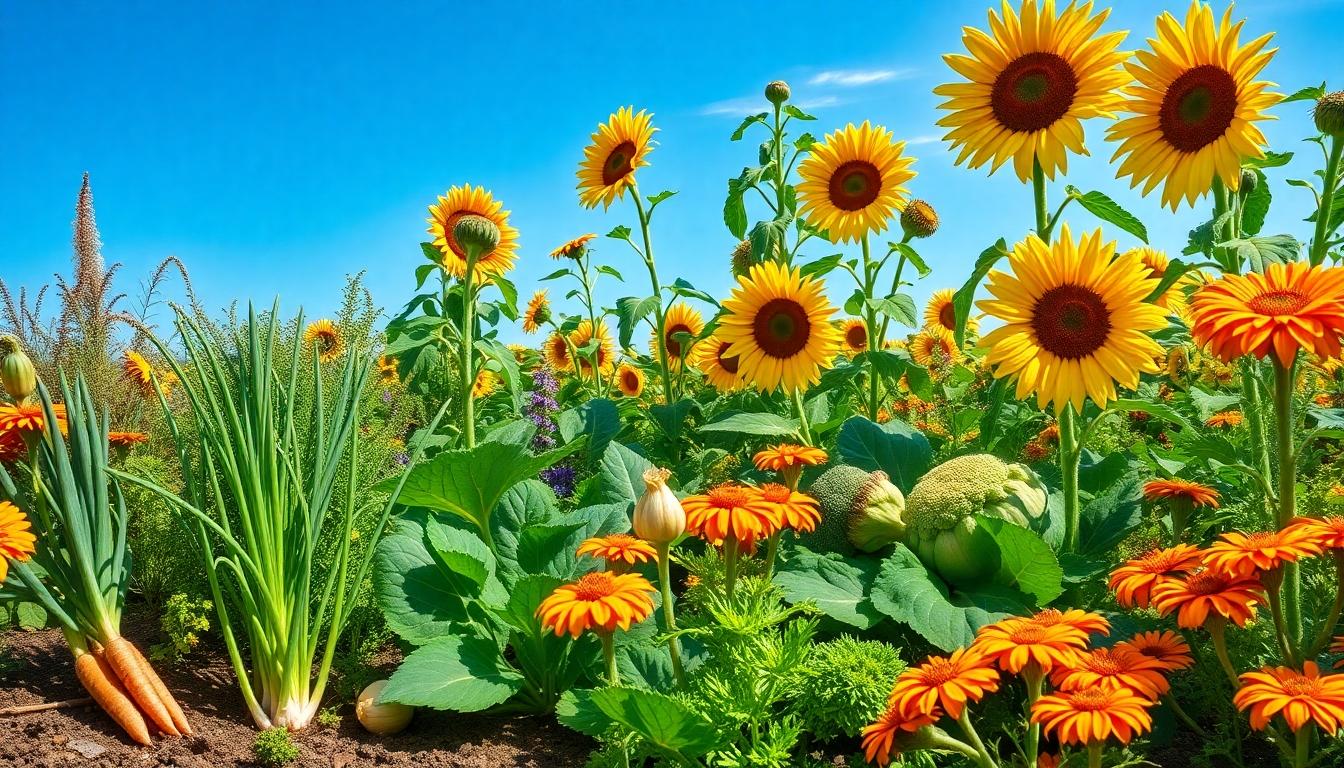
Companion planting is one of the most effective natural methods to enhance your fall garden’s productivity and resilience. By strategically pairing compatible plants, we can create a more balanced network that minimizes pest problems while maximizing space utilization.
Beneficial Combinations for Pest Management
Carrots and leeks form an ideal partnership in fall gardens, as leeks effectively repel carrot flies that typically damage carrot crops. This natural pest management strategy eliminates the need for chemical interventions while ensuring healthier root development for your carrots.
Spinach grows exceptionally well when surrounded by aromatic herbs like oregano and rosemary. These strong-scented herbs act as natural insect repellents, creating a protective barrier around your spinach plants and reducing pest pressure significantly.
Garlic and broccoli make excellent companions in fall gardens because garlic’s pungent compounds naturally deter many brassica pests. Planting garlic between your broccoli plants can help minimize cabbage worms and other common fall garden pests.
Remember to avoid planting garlic near legumes such as peas or beans. This combination creates soil nitrogen imbalances that can stunt plant growth and reduce your overall harvest quality.
Space-Saving Plant Pairings
Sunflowers serve as natural trellises for climbing vegetables like cucumbers and pole beans in fall gardens. Their strong stalks provide excellent support while creating partial shade that protects more delicate plants from intense afternoon sun.
Cucumbers benefit tremendously when planted alongside marigolds or nasturtiums. These companion flowers not only add vibrant color to your fall garden but also repel aphids and beetles that commonly attack cucumber plants.
Spinach and celery create a mutually beneficial relationship when planted together in fall gardens. Their complementary root structures allow them to share space efficiently without competing for nutrients or water.
By implementing these companion planting strategies, your fall garden will develop stronger natural defenses against pests while maximizing your growing area. These plant combinations work with nature rather than against it, creating a more sustainable and productive gardening system as temperatures begin to drop.
Managing Pests and Diseases in Your Fall Garden
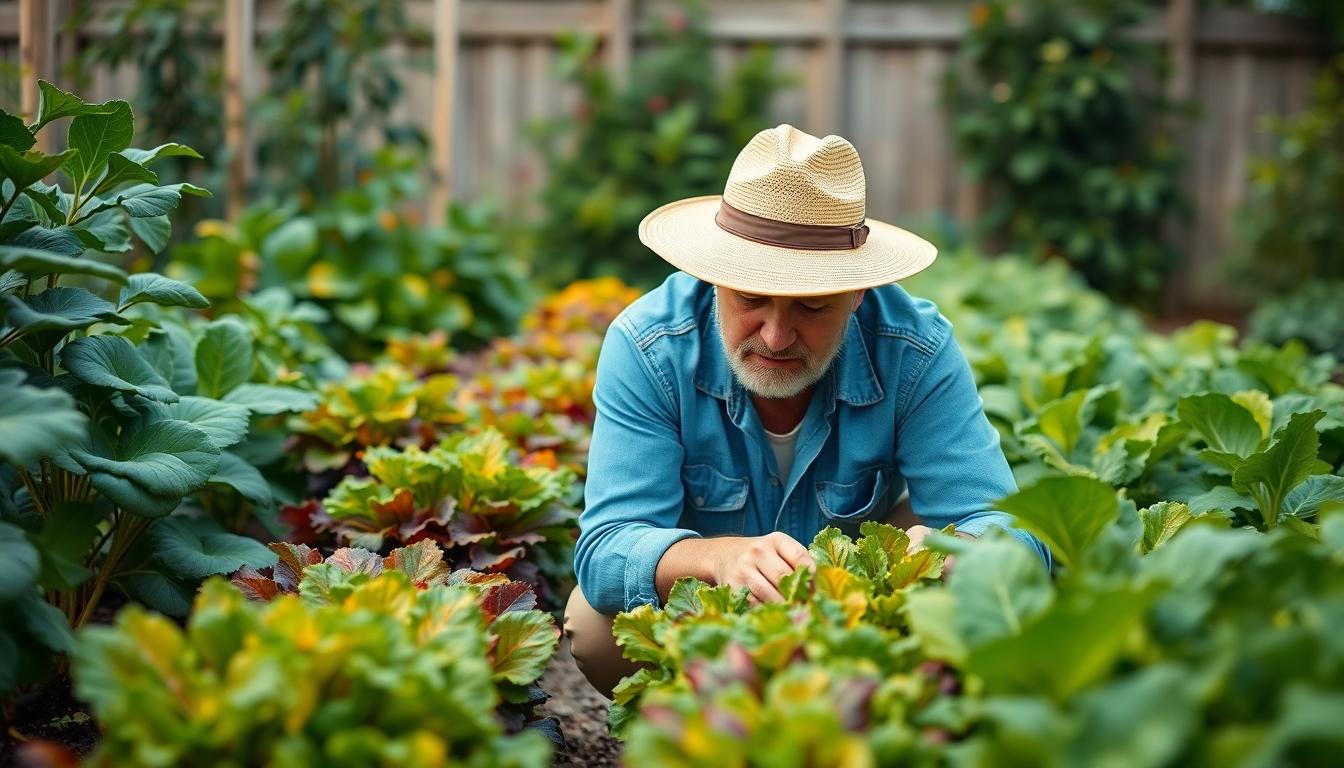
While fall brings ideal growing conditions for many cool-season crops, it also presents unique pest and disease challenges that require vigilance to protect your harvest.
Common Fall Garden Pests and Natural Answers
Aphids remain persistent threats in fall gardens, often clustering on the undersides of leaves and stunting plant growth. These tiny pests can be effectively managed with neem oil or insecticidal soap applications, creating a natural barrier that doesn’t harm beneficial insects. Cabbage loopers pose important risks to brassica crops like broccoli and cauliflower, chewing irregular holes in leaves that can devastate young plants. We’ve found that installing row covers provides excellent protection against these pests while still allowing sunlight and water to reach your vegetables. Flea beetles jump quickly between plants, creating distinctive small holes that can weaken seedlings and reduce yields. Encouraging beneficial insects offers a sustainable solution to these common pests—ladybugs and lacewings act as natural predators, helping maintain the ecological balance in your fall garden.
Preventing Cold-Weather Plant Diseases
Fungal diseases thrive in the moist conditions typical of fall gardens, with powdery mildew and leaf spot affecting many vegetable varieties. Proper air circulation serves as your first line of defense, so we recommend adequate spacing between plants to reduce humidity around foliage. Rot problems often develop when excessive moisture remains around plant roots or fruits touching the soil surface. Improving soil drainage through raised beds or adding organic matter helps prevent these destructive conditions before they start. Always practice good garden hygiene by promptly removing any diseased plant material from your garden, preventing spores from spreading to healthy plants. Copper-based fungicides can be applied as a last resort when other prevention methods prove insufficient, offering protection against various fungal and bacterial pathogens. Creating the right growing environment with proper watering practices—watering at the base of plants rather than overhead—significantly reduces disease pressure in your fall vegetable garden.
Fall Garden Maintenance Essentials
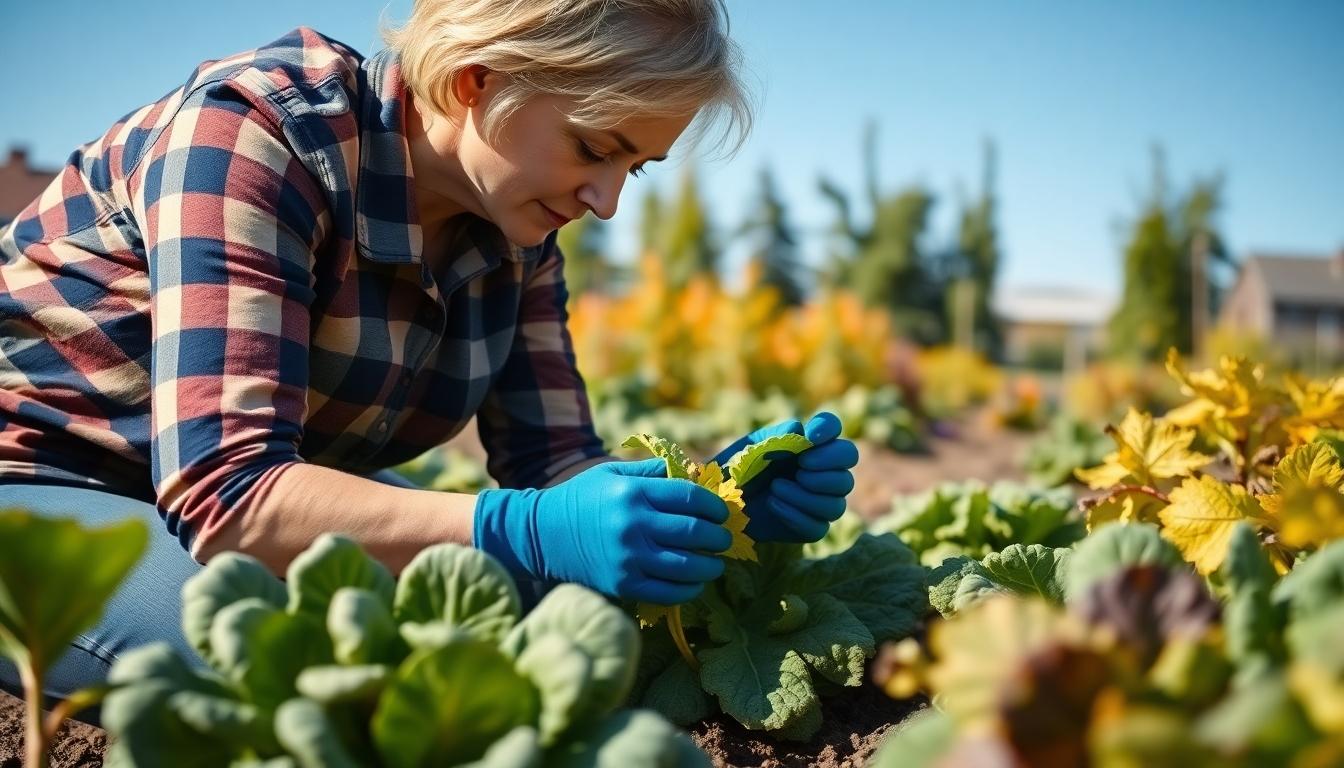
Maintaining your fall vegetable garden requires different approaches than summer gardening. As temperatures begin to drop, these essential maintenance practices will help ensure your cool-season crops thrive until harvest time.
Watering Adjustments for Cooler Weather
Fall gardens require significantly less water than summer gardens due to cooler temperatures and reduced evaporation rates. We recommend scaling back your watering frequency while still maintaining consistent soil moisture levels to support healthy plant development. Morning watering is ideal during fall months, allowing foliage to dry completely before evening temperature drops. Check soil moisture by inserting your finger about an inch into the soil—only water when it feels dry at this depth. Overwatering in cooler weather can lead to root rot and fungal diseases, particularly problematic when plants have slower growth rates. Drip irrigation systems work exceptionally well for fall gardens, delivering water directly to the root zone without wetting foliage.
Pruning and Cleanup Practices
Regular pruning and garden cleanup are crucial for fall garden health and productivity. Remove any garden debris or dead plants promptly to prevent disease spread and create a healthier growing environment for your vegetables. Prune spent or yellowing leaves from crops like lettuce, spinach, and other leafy greens to encourage new growth and extend your harvest period. Clear away summer crop residues completely, as they can harbor pests and diseases that might affect your fall plantings. Inspect plants weekly for signs of pest damage or disease, removing affected portions before problems can spread. Collect fallen leaves from nearby trees and compost them separately or use as mulch rather than letting them accumulate on garden beds. Maintain clean pathways between rows to reduce weed pressure and make harvesting easier as the season progresses.
Harvesting and Preserving Your Fall Bounty
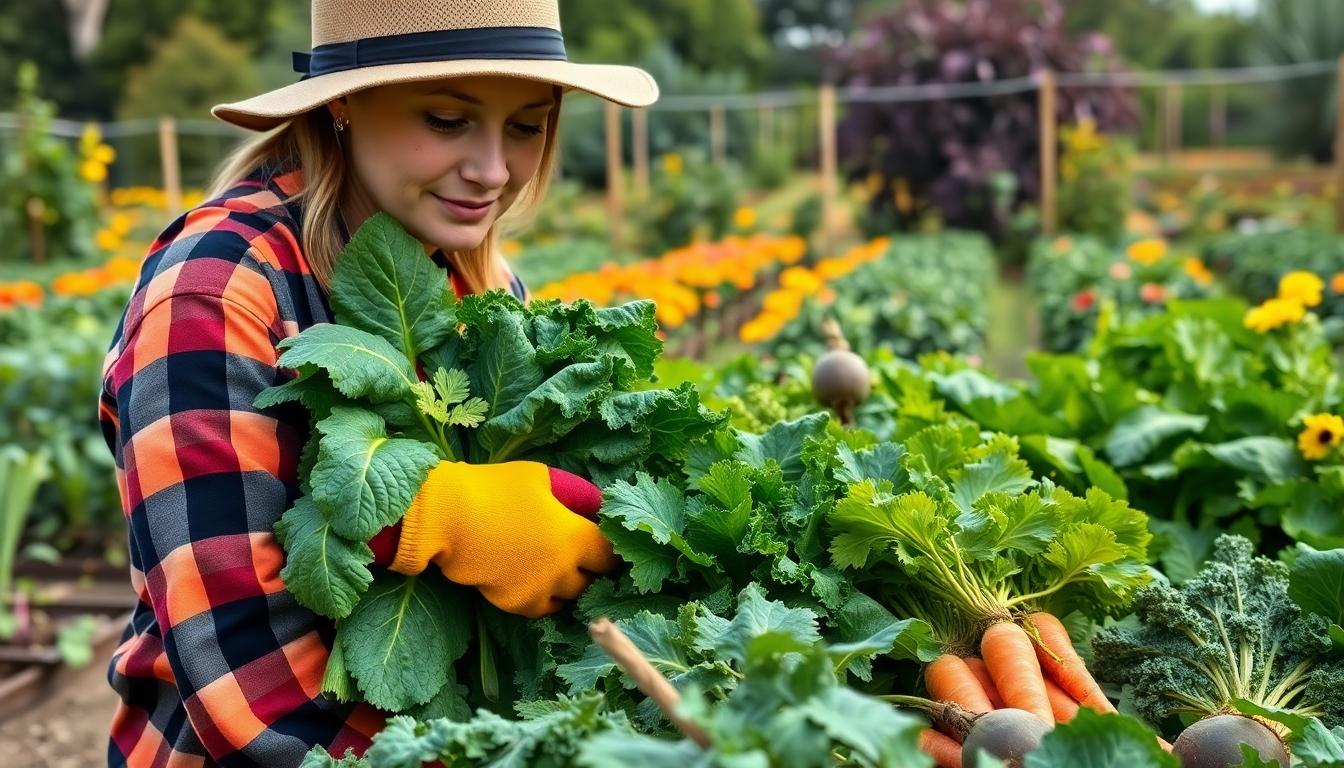
Knowing when and how to harvest your fall crops ensures maximum flavor and nutrition. Collect leafy greens when they reach usable size, and wait until after light frosts to harvest root vegetables for enhanced sweetness.
Storage Techniques for Root Vegetables
Root vegetables like carrots, beets, and turnips require exact storage conditions to maintain their freshness through winter. Store these vegetables in cool environments with temperatures between 32–40°F and high humidity levels to prevent withering. Perforated plastic bags work excellently for refrigerator storage, maintaining the necessary moisture while allowing some airflow. Another effective method involves layering your root vegetables in damp sand inside a root cellar, which naturally maintains ideal temperature and humidity conditions. This traditional technique has been used for generations to preserve root crops through winter months without electricity.
Preserving Methods for Fall Greens and Herbs
Freezing: Blanch leafy greens such as spinach and kale for 2–3 minutes in boiling water before plunging them into ice water. This process preserves color, flavor, and nutrients before storing in airtight containers in your freezer for up to 12 months.
Drying: Herbs like parsley and thyme retain their flavors when properly dried. Hang small bundles upside down in a dark, well-ventilated area, or use a dehydrator set to 95–115°F until the herbs become crispy to the touch. Store dried herbs in airtight containers away from light to maintain potency.
Fermenting: Transform cabbage into probiotic-rich sauerkraut by combining shredded leaves with salt in a ratio of about 2.5% salt by weight. Pack this mixture into anaerobic jars, ensuring the cabbage remains submerged under its liquid for proper fermentation.
Canning: Pressure canning is essential for preserving low-acid vegetables like collard greens safely. Process these greens at 240°F for 10–75 minutes depending on jar size, always following current USDA guidelines to ensure food safety. This method provides shelf-stable greens that can be enjoyed long after the growing season ends.
Planning Ahead: Using Your Fall Garden to Prepare for Spring
Embracing fall vegetable gardening opens up a industry of delicious possibilities while setting the stage for next year’s success. By implementing cold-hardy crops protective structures and companion planting techniques we’ve shared you’ll enjoy fresh harvests well into the cooler months.
Don’t forget that your fall garden work pays dividends beyond this season. The soil amendments mulching and crop rotation you practice now will create healthier growing conditions next spring. Take time to document what thrived in your autumn garden so you can refine your approach year after year.
Ready to get started? Grab those seed packets prepare your beds and enjoy the unique rewards of fall gardening. Your dinner table and future garden will thank you!
Frequently Asked Questions
What vegetables grow best in a fall garden?
Cold-hardy vegetables thrive best in fall gardens. Top choices include kale, Brussels sprouts, broccoli, cauliflower, spinach, lettuce, arugula, beets, radishes, and carrots. These vegetables not only tolerate cooler temperatures but often develop sweeter flavors when exposed to light frost. Root vegetables like carrots and beets store energy in their roots as temperatures drop, creating a more flavorful harvest.
When should I start planting my fall garden?
Calculate backward from your first expected frost date. Most fall vegetables should be planted 8-12 weeks before the first frost to ensure they have enough time to mature. For example, if your first frost typically occurs in mid-October, you should begin planting in mid-July to late August, depending on each vegetable’s specific maturation period.
How do I prepare soil for fall planting?
Start by removing summer crop debris and weeds. Conduct a soil test to check pH and nutrient levels (aim for slightly acidic to neutral pH). Incorporate 2-3 inches of high-quality compost to improve soil structure and fertility. Add organic fertilizers based on your soil test results, and consider adding bone meal for root vegetables. Allow the soil to rest for a few days before planting.
What is succession planting and why is it important for fall gardens?
Succession planting involves sowing seeds at intervals rather than all at once. This technique ensures continuous harvests throughout the fall season as earlier plantings are replaced by new ones. For quick-growing crops like radishes or lettuce, plant new seeds every 1-2 weeks. This maximizes garden productivity and provides fresh vegetables over a longer period.
How can I protect my fall garden from frost?
Use protective structures like cold frames, row covers, or cloches to shield plants from frost. Cold frames create mini greenhouse environments that trap heat, while lightweight row covers can be draped directly over plants. For unexpected frosts, temporary protection using old sheets, blankets, or plastic containers can save crops. Remember to provide ventilation on sunny days to prevent overheating.
Can I grow fall vegetables in containers?
Absolutely! Containers are excellent for fall gardening, especially with limited space. Use pots at least 12 inches deep for root vegetables and 6-8 inches for leafy greens. Kale, lettuce, spinach, carrots, and beets adapt well to container growing. Choose a high-quality potting mix with good drainage, and place containers where they receive adequate sunlight but can be easily moved to avoid frost.
What companion plants work well in fall gardens?
Beneficial fall companion plantings include carrots with leeks (pest deterrence), spinach with aromatic herbs (flavor enhancement), and garlic with broccoli (disease prevention). Plant calendula or marigolds throughout the garden to repel pests naturally. Pairing tall plants with low-growing ones maximizes space efficiency while creating microclimates that benefit both plants.
How should I adjust watering for my fall garden?
Fall gardens typically require less frequent watering than summer gardens due to cooler temperatures and reduced evaporation. Water deeply but less often, keeping soil consistently moist but not waterlogged. Morning watering is best to allow foliage to dry before evening, reducing disease risk. Apply mulch to retain moisture and regulate soil temperature as weather cools.
What are common fall garden pests and how can I manage them?
Common fall pests include aphids, cabbage loopers, and flea beetles. Use neem oil or insecticidal soap for aphids, Bacillus thuringiensis (Bt) for cabbage loopers, and row covers for flea beetles. Encourage beneficial insects like ladybugs and lacewings by planting flowers nearby. Regular monitoring is essential—inspect the undersides of leaves weekly and address problems early before they spread.
What’s the best way to preserve my fall harvest?
For root vegetables like carrots and beets, store in cool (32-40°F), humid conditions in sand or sawdust. Freeze leafy greens like kale and spinach by blanching first, then packing in airtight containers. Many fall herbs can be dried or frozen in oil in ice cube trays. Fermentation works well for cabbage and radishes, while quick-pickling extends the life of various vegetables. Proper curing extends the storage life of garlic and onions.

